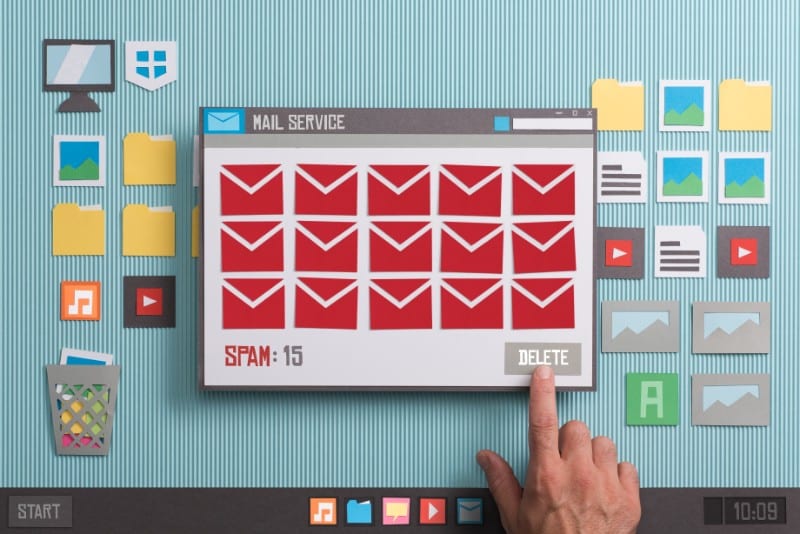Email marketing is a wonderful way to inform your audience about what exactly your business offers. Email marketing is one of the most popular and effective tools to help grow your business. While it is true that email marketing can help develop a positive relationship between your business and your customer, recipients can overlook many promotional emails. So, how can you make sure your emails don’t end up in the spam folder?
This article will discuss reasons why your emails end up in a spam folder and ways to avoid that fate. This article will also give you some insight into spam filter tests as well as deliverability tests.
Table of Contents
Email Marketing
Email marketing is the use of email to promote your business’s products and services. There are a ton of advantages to email marketing due to its cost-effective nature and usability. Email marketing is a tool that many businesses should employ in their marketing campaigns. On the other hand, there are also some downsides to email marketing to consider. For example, perhaps you already are using email marketing, but are not seeing the results that you were expecting.
Across industries, the average open rate for emails is 20.94%. This number represents the percentage of email recipients that actually open emails rather than direct promotional emails to spam or leave these emails untouched and unopened.
There are several reasons why your emails are being marked as spam. Perhaps you are sending out bulk emails that look like spoof emails, your sender reputation isn’t very good, or you need email authentication. Whatever your reason for looking for ways to improve your email marketing techniques, let’s take a look at why your emails may be going to spam.
Why Are My Emails Going to Spam? The Top Ten Reasons Email Goes to the Spam Folder
To avoid your email marketing going straight to the spam folder, let’s discuss the ten reasons emails end up becoming spam.
1. You Don’t Have Permission
The biggest rule of email marketing is to get permission to email before sending any promotional content. There is an actual law that details the in and outs of email marketing etiquette. The CAN-SPAM Act covers various aspects of the email marketing process, so it may be in your best interest to read it over, as there are some hefty penalties for non-compliance.
Also randomly sending promotional content – no matter how valuable it may be – can make your recipients uneasy. They may simply block your content, or send it straight to spam because they do not know or care what you offer. This is why it is not advisable to buy an email list.
2. Sender Information is Inaccurate
Your “from” information needs to reflect who you and your business is. Your email address, routing information, and sign off should all appear to be from the same sender. The recipient of your email must be able to identify who exactly sent the message. Mismatched information can appear as spam and recipients might label it as untrustworthy. Your emails must clearly state who you or your company is and avoid any inaccurate information.

3. No Physical Address is Included
Your emails must include a physical address. This could be a current street address, a post office box you have registered with the U.S. Postal Service, or a private mailbox. If you do not include a valid address, our emails might be marked as spam. This stems back to the idea that you and company must have traceability. Businesses often include their physical address at the bottom of their emails.
4. Spam Trigger Words
Some spam filters are triggered by certain words in the subject line or in the body of an email. Email providers may also have built-in tools to scan incoming emails for spam trigger words. There are a handful of tools out there that can help identify words that may trigger spam filters. There is an extensive list of spam trigger words to avoid in your marketing emails.
5. Subject Line is Weak or Misleading
An email’s subject line is extremely important. It is one of the main deciding factors for is the recipient will actually open your email and take a look at the inside content. If your email subject line is weak or questionable, your recipient may just ignore your email entirely. Not only will using a misleading subject line make your audience feel cheated or deceived, there are also laws preventing you from misleading your audience. The CAN-SPAM Act includes rules regarding a misleading subject line, so it is important to put effort into developing a strong and accurate subject line.
6. You Have Included Attachments
Avoid attachments in your email marketing. There are many reasons to avoid attachments. Attachments trigger spam filters and reduce the chances of your email reaching the recipient. Attachments also can look a bit deceitful. As far as your audience knows, your attachment could harbor a computer virus. Lastly, attachments often end up slowing the loading time of your emails. There is really no reason to include an attachment in your commercial emails. The body of your email should include all the important information.

7. You Have Low Engagement Rates
Some webmail providers can look at the amount of emails that are opened and how many emails are deleted without ever being opened as a factor of spam filtering. If your email marketing does not have high open rates, your emails are at risk for being considered as spam by email providers.
Increase your open rates by sending out emails at the best time for your company, using high quality subject lines, and keeping your email list fresh and reliable.
8. You are Sending Emails to Inactive Addresses
Sending out emails on a large scale to inactive email addresses can hurt your company’s email marketing ‘reputation’ to email providers. Spam filters may see this as a trend in your business’s email marketing campaign and decide that your emails are spam. To ensure that this does not happen, make sure that you clean out your email list and delete inactive email addresses.
9. You Have Incorrect Spelling and Grammar
Spam filters are on high alert for any spelling or grammatical errors in promotional emails. You also may look unprofessional to your audience. Be careful about the emails that you send out as email spell-check may not catch every error. There are a handful of online tools that can help with grammar but proofreading by a legitimate person sometimes is best for catching readability issues.
10. There is No Opt-Out Link
An “unsubscribe” link is essential for promotional emails. No matter how valuable you believe your content to be, you still need to give your subscribers a way to opt out of your emails. Opt-out links are legally required for any email marketing. It is also incredibly annoying to your audience if they cannot opt-out of emails they are uninterested in. If you do not include an opt-out link in your email marketing, you may end up in a spam folder by an annoyed recipient or get fined by the Federal Trade Commission.

Spam Filter Test
Spam filters are often a source of frustration for small business owners. While filters can prevent junk mail from piling up in inboxes, they can also mistake legitimate emails as spam. Spam filters cannot work at 100% accuracy. There are ways to test whether or not your emails are being sent straight to the spam folder.
A spam filter test allows you to see how your email marketing campaign will look in your audience’s inbox. It will be able to tell you if your emails end up making it to your audiences’ inbox or triggering any spam filters. The idea is to make sure that your promotional emails pass any spam filter tests so that your emails end up in the space you want them to be. There are spam filter tests that are available in many spaces. There are a variety of email marketing platforms available that can help you with all the aspects of your email marketing campaign, including spam filter tests.
Email Deliverability Test
Email deliverability is whether an email was delivered into your audience’s inbox or skipped straight to the spam folder. This test measures your email’s ability to end up in the right place. Maybe you edited your emails and scrutinized them to make sure they are perfect. Unfortunately, there is still a chance that your emails are not making it to your subscribers. There are many ways to improve your email deliverability but oftentimes looking to experts may have the best results.
Effective email marketing means your emails are reaching your audience. This means that your emails are passing through as planned to your audience without being labelled as spam. The rate that your emails actually end up in recipient inboxes is crucial to monitor for the success of your email marketing campaign.

Still Need Email Marketing Help?
Email marketing is a great tool to create an edge for your business. While it does make digital marketing easy, it is not without faults. Without proper maintenance, it is possible that your email marketing campaign can fall through the cracks and end up not very useful towards your goals and mission.
If you do not have enough time or the expertise to manage your email marketing campaign, you can turn to agencies that can do it for you. SEO Design Chicago offers many digital marketing services, including email services, that can assist your company! We help our email clients ensure that their marketing email never go into the spam folder, and we never send spam.
FAQ:
- Why was my email marked as spam?
- Why are my emails going into recipients’ spam folders?
- What is a spam filter test?
- What is an email deliverability test?
- How effective is email marketing?



Contact Us Today!